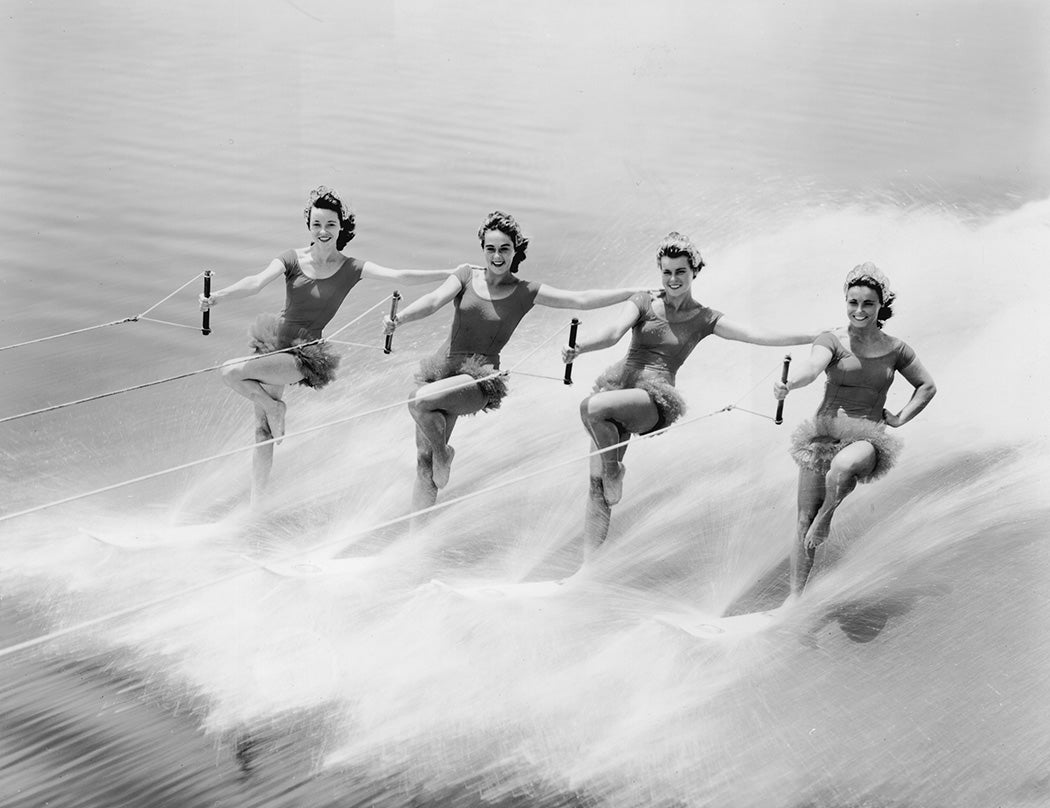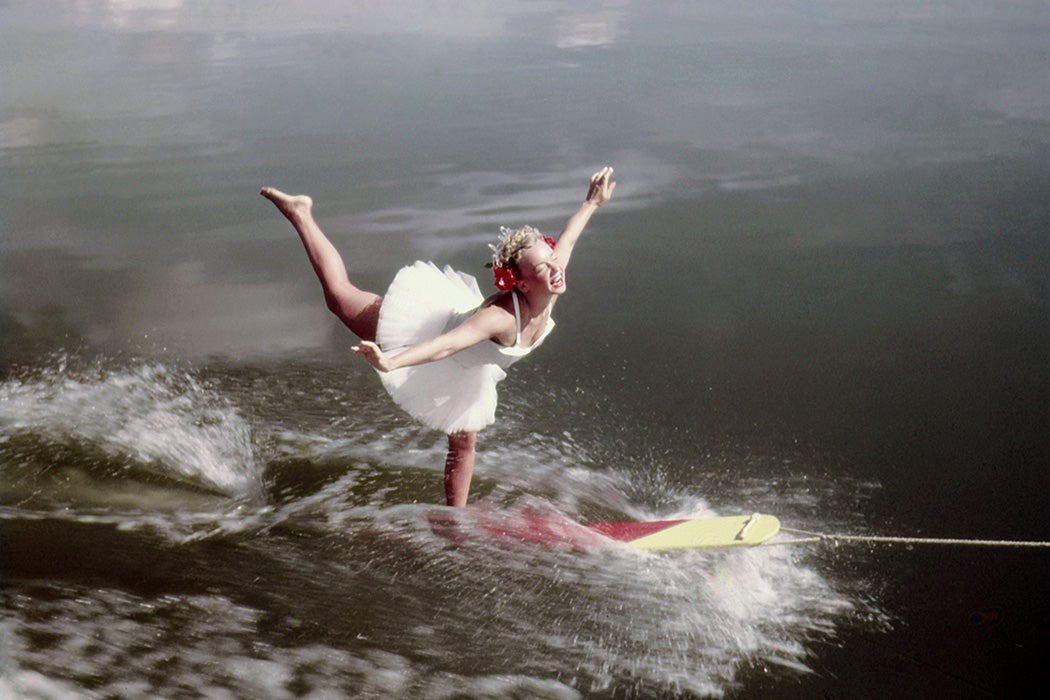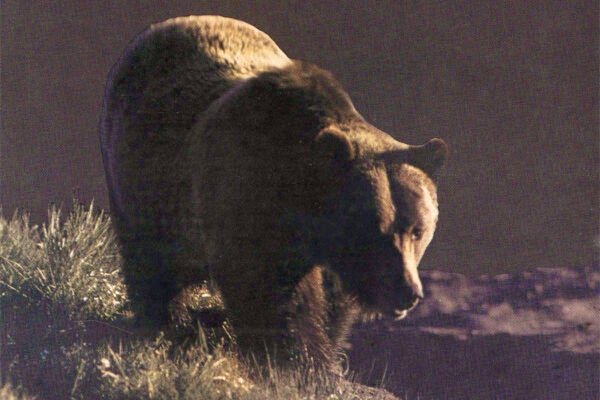When I was dating my now spouse many years ago, one of the added benefits to seeing him was the chance to hang out with his next-door neighbor. A charming, eccentric older woman, she invariably shared wild and wonderful stories from her younger days. Par for the course: she was featured in Sports Illustrated in 1962 as a performing water-skier.
This is very cool now, but, believe it or not, it was perhaps even cooler then: in the mid-twentieth century, it was hard to think of someone who epitomized more allure, cool, and skill than one of the “Winter Haven girls” of Florida’s Cypress Gardens.
Water skiing is a reasonably new, American invention in the world of performance and competition. Most folks trace its origin to Lake City, Minnesota, where a teenager named Ralph Samuelson put together some makeshift and ridiculously heavy wooden skis and decided to try hanging on for amusement and dear life behind a twenty-four-foot speedboat in 1922.
Minnesota curator Sondra Reierson explains that “despite broken skis and several failed attempts” at getting up on the water,
on the third day Samuelson successfully rode the water of Lake Pepin aboard a pair of nine-foot-long pine planks from the local lumberyard. Samuelson had softened and curved the tips of the boards using his mother’s wash boiler and reinforced them with metal strips.
Three years later, Samuelson greased up a homemade wooden ramp—four feet wide, sixteen feet long—and landed the first water-ski jump.
Midwestern lakes were an ideal testing ground for water skiing, even if the season was short: calm water, close to shore, plenty of lakes and boaters already available. And the Midwest continued its pursuit of water-ski showmanship, notably through Wisconsin’s Tommy Bartlett, but it was in Florida that the sport took off, soon becoming a cultural shorthand for mid-century American pageantry.

Florida went through a boom-and-bust cycle in terms of development and tourism in the 1920s. The upswing was aided by media buzz and car culture, but the state was vulnerable to things like hurricanes, housing shortages, fruit flies (affecting citrus harvests and therefore economic prosperity), and banking busts. After a real estate collapse in 1926, no one was bullish on Florida—especially not central Florida. Librarian Dorothy Mays explains that “[t]he deplorable condition of Florida’s road system meant that long-distance travel was practical only via railroad.” Consequently, “[t]he interior of Florida remained largely unaffected by tourism as the railroads bypassed most of the state and funneled tourists directly to opulent resorts in the coastal cities of St. Augustine, Miami, and Tampa.”
When tourism started to recover in the 1930s, despite the Depression, entrepreneur Dick Pope saw an opportunity and capitalized on it, founding a park and a vaguely Venetian-style pleasure garden in Winter Haven. The so-called “Swami of the Swamp” opened his business in 1935, calling it Cypress Gardens.
Cypress Gardens became well known for a variety of entertainments, many of which emphasized conventionally beautiful women. This was due to Pope’s wife, Julie, who ran the park while Dick was serving in World War II and who zeroed in on southern belles and bathing beauties to bring off-duty soldiers (who would become tourists after their discharge) into the establishment. Historian Stephen E. Branch credits Julie Pope with introducing iconic showy skiing displays.
“When Dick Pope returned from service,” Branch writes, “he saw the long term [sic] potential of Julie’s idea and set out to institutionalize the performances. In 1947, barefoot water skiing premiered at Cypress Gardens, and Dick Pope Jr. was featured performing this new feat on national newsreels.”
The combination of thrills, athleticism, and lithe beauty was a near-instant success; the February 17, 1947, edition of Life magazine proclaimed that “[i]n any Florida season two of the surest ways for a pretty girl to get publicity are to become citrus queen and to be photographed on water skis.”
More to Explore
A Brief History of Skis
Water-skiing performances became showier and more complex over time, involving coordinated costumes, props, pair stunts, and perfectly posed pyramids. In addition to the pure entertainment factor, water skiing telegraphed a particular image of ideal femininity and a carefree sense of performative American prosperity. It perhaps goes without saying that the “Winter Haven girls” were uniformly attractive. Commentary on their performances generally emphasized beauty at the cost of minimizing their incredible athleticism. In a 1958 video, which makes my core hurt just watching it, the narrator peppers his commentary with flirty remarks and points out that the ski-team women are full of “pulchritude and feminine charm,” with a sure “flock of Johnnys waiting” after the show.
Water-ski shows became emblematic of a certain squeaky-clean breed of American pop culture. Sometimes this translated into a sense that there could be nothing amiss in a world where it was perpetually summer: colorful magazine spreads showed perfect pin-up girls and sleek, tanned men against the backdrop of lovely beaches, with hot dogs grilling. In other cases, the shows served to demonstrate prevailing bias among those Americans affluent enough to attend the shows in Cypress Gardens and similar venues (the Confederate flag flapping a-top of a skiing pyramid in the 1970s was unremarkable).
Weekly Newsletter
According to Mays, Cypress Gardens held strong as a little piece of escapist paradise well into the 1970s. By that time, though, they were far from the only game in town, facing as they were competition from Sea World, Walt Disney World, and Busch Gardens.
“Known primarily for its fabulous gardens, stately southern belles, and water-skiing shows,” Mays writes, “Cypress Gardens appealed to an older generation and it was difficult to lure families with children away from Mickey and Shamu.”
The Popes sold the Winter Haven park in 1985, and the property changed hands multiple times over the years before becoming part of Legoland’s Florida location. The water-ski show closed for good only in December 2024, with one final show on the eve of New Year’s Eve.
Support JSTOR Daily! Join our membership program on Patreon today.








